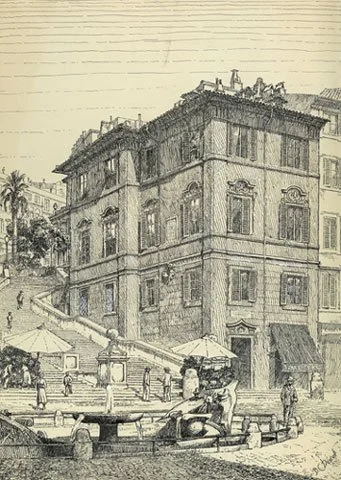History of the Association
The Keats-Shelley Association of America came into existence as a belated offshoot from an Anglo-American philanthropic consortium that in 1903 purchased the house in Rome in which John Keats died. The badly deteriorated edifice was subsequently converted into a museum and library and opened to the public as the Keats-Shelley Memorial House in 1909. (In 1819 the Shelley family had rented quarters on the Via Sistina, the street directly behind the house above the Spanish Steps; hence the easy association of Keats and the Shelleys.) The house at 26 Piazza di Spagna has been administered ever since by the British Keats-Shelley Memorial Association, with additional and substantial gifts initially coming from an American committee composed of bibliophiles and philanthropists, in addition to rents from apartments in the building not integrated into the Keats-Shelley House. With the advent of World War II the intrepid curator, Vera Cacciatore, sequestered its rare books and valued relics outside the city, then removed identifying markers, and closed the House for the duration of the war. For all that attempt to hold on for another day, however, after the war, its finances were in such dire straits that it could not be reopened without a fundamental restructuring.
This is the point (1949) at which in England and the United States separate committees were formed to revivify interest in the second generation of British Romantic poets and to secure a financial basis for the Memorial that symbolized and honored their lasting value. To enlarge the basis for their endeavor from the small nucleus that had bought and supported the house, both committees invited in a general public of academicians and literary connoisseurs and began to publish annual periodicals with slightly different foci: the British Keats-Shelley Memorial Bulletin (now the Keats-Shelley Review) was revived in 1950, with a bias toward biography, literary associations, and primary texts, and the American Keats-Shelley Journal (subtitled Keats, Shelley, Byron, Hunt, and Their Circles) debuted in 1952, with an abiding interest in academic literary criticism and scholarship. Yet, though the preponderance of articles in the first issues of the K-SJ came from academic sources, the initial President of the association was Ruth Draper, the celebrated theatrical monologist, and the Vice-President was one of the great book collectors of mid-century, Arthur A. Houghton, Jr. From the beginning, then, the association attempted to form a bridge between the academy and general public with strong literary interests. With the accelerating growth of an academic-industry called British Romanticism, however, abetted by the slow decline of the book culture that initially formed the heart of the Keats-Shelley alliance in England, Italy, and the United States, the structural underpinnings of that bridge have grown less substantial year by year, a dynamic our current strategic plan seeks to correct.
The K-SAA has published the Keats-Shelley Journal annually since 1952, adding an annual bibliography in the field in 1971. For a generation after its inception the K-SJ held an undisputed place as the central venue for major scholarship in British Romanticism. Since the 1980s, under a succession of specialist editors (Stuart Curran, Steven Jones, Jeanne Moskal, Jonathan Mulrooney), K-SJ has maintained a reputation as a rigorously vetted scholarly journal serving the Romantic movement. See the K-SJ section for more on the goals, editorial team and policies, and recent issues of the journal.
This history was thoughtfully compiled by Professor Stuart Curran.
Strategic Planning
In 2019-2020 we initiated a strategic planning process to develop a set of new goals to see the Association into the future. Our year-long discussions consolidated our values of supporting scholarship on Keats, the Shelleys, their circles, and the larger early-nineteenth-century archive; engaging the public; creating pathways for inclusivity and diversity within the organization and beyond; and continuing to build community within the academy and the wider public.
This work was informed by the following six priorities:
1) Building infrastructure for administrative governance, and communications, as well as a capacity for greater academic and public engagement
2) Increasing programs, membership, international partnerships, and audience through the Romantics 200 and Frankenreads initiatives
3) Increasing support for early career and independent Romanticists
4) Expanding beyond our primarily national scope
5) Bringing the Keats-Shelley Journal into line with this broader vision
6) Building upon recent fundraising successes to help support our work
To continue this work, our goals have included diversifying our Board and our collaborators, seeking member engagement in our events, creating new avenues of programming for our members and public audiences, expanding our communication on multiple platforms, reviewing our officers’ roles, formalizing the processes for selection of our awards and the nomination of new Board members, and conducting a formal review of the Keats-Shelley Journal which eventuated in the selection of a new editor and a team of reviews editors. We are now well poised to realize our vision and make our Association even stronger, more inclusive, and more sustainable.
In 2005, Prof. Jeanne Moskal (former editor of the Keats-Shelley Journal) founded K-SAA’s Mentoring Project. Her goal was to bring together established scholars who did not have current graduate students, and early-career faculty seeking in-field professional guidance. We are proud to say that, since its creation, this initiative has served more than 70 junior scholars! Our other current projects include a new grant-funding initiative titled Romantic Futures; a High School Outreach Program through which we will tailor classroom resources for secondary-school teachers who wish to include the Romantics in their curricula; and the addition of new Communications features to our blog and website, designed to enhance member engagement. Beyond these new developments, we continue to offer our established Curran Symposia, MLA panel and awards dinner, Pforzheimer grants, and interactive May Members’ Meetings.
We hope you’ll join us and contact us with any ideas you have for sustaining and enlivening our community.


